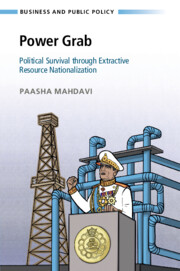Book contents
- Frontmatter
- Dedication
- Contents
- Contents
- List of Tables
- Acknowledgements
- 1 The Puzzle of Extractive Resource Nationalization
- 2 The Theory of Political Survival through Nationalization
- 3 Defining and Measuring Operational Nationalization
- 4 Why Nationalize? Evidence from National Oil Companies around the World
- 5 NOCs, Oil Revenues, and Leadership Survival
- 6 The Dynamics of Nationalization in Pahlavi Iran
- 7 Conclusion: The Implications of Nationalization
- Bibliography
- Index
4 - Why Nationalize? Evidence from National Oil Companies around the World
Published online by Cambridge University Press: 31 March 2020
- Frontmatter
- Dedication
- Contents
- Contents
- List of Tables
- Acknowledgements
- 1 The Puzzle of Extractive Resource Nationalization
- 2 The Theory of Political Survival through Nationalization
- 3 Defining and Measuring Operational Nationalization
- 4 Why Nationalize? Evidence from National Oil Companies around the World
- 5 NOCs, Oil Revenues, and Leadership Survival
- 6 The Dynamics of Nationalization in Pahlavi Iran
- 7 Conclusion: The Implications of Nationalization
- Bibliography
- Index
Summary
Chapter four empirically assess the veracity of the argument on why leaders nationalize their oil sectors and establish operational national oil companies (NOCs). To test hypotheses derived from the theory’s implications, this chapter presents the findings from a method of statistical analysis that combines the cross-national NOC dataset with information elicited from structured interviews with oil experts. This technique -- Bayesian statistics -- allows for a holistic analysis of the determinants of nationalization that incorporates both quantitative and qualitative evidence on NOC formation. The results show the importance of information diffusion and perceptions of leader survival in the decision to nationalize the oil sector. The chapter then offers a case comparison of Iran and Saudi Arabia in the 1940s to show how information diffusion to a strong regime led to maintaining private ownership in Saudi Arabia in 1949, while knowledge about revenue sharing diffused to a weak regime led to nationalization in Iran in 1951.
Keywords
- Type
- Chapter
- Information
- Power GrabPolitical Survival through Extractive Resource Nationalization, pp. 104 - 139Publisher: Cambridge University PressPrint publication year: 2020

